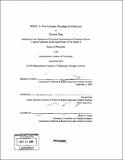NIRA : a new Internet routing architecture
Author(s)
Yang, Xiaowei, 1974-
DownloadFull printable version (11.27Mb)
Alternative title
New Internet routing architecture
Other Contributors
Massachusetts Institute of Technology. Dept. of Electrical Engineering and Computer Science.
Advisor
David Clark.
Terms of use
Metadata
Show full item recordAbstract
(cont.) mechanism, a user only needs to know a small region of the Internet in order to select a route to reach a destination. In addition, a novel route representation and packet forwarding scheme is designed such that a source and a destination address can uniquely represent a sequence of providers a packet traverses. Network measurement, simulation, and analytic modeling are used in combination to evaluate the design of NIRA. The evaluation suggests that NIRA is scalable. The present Internet routing system faces two challenging problems. First, unlike in the telephone system, Internet users cannot choose their wide-area Internet service providers (ISPs) separately from their local access providers. With the introduction of new technologies such as broadband residential service and fiber-to-the-home, the local ISP market is often a monopoly or a duopoly. The lack of user choice is likely to reduce competition among wide-area ISPs, limiting the incentives for wide-area ISPs to improve quality of service, reduce price, and offer new services. Second, the present routing system fails to scale effectively in the presence of real-world requirements such as multi-homing for robust and redundant Internet access. A multi-homed site increases the amount of routing state maintained globally by the Internet routing system. As the demand for multi-homing continues to rise, the amount of routing state continues to grow. This dissertation presents the design of a new Internet routing architecture (NIRA) that simultaneously addresses these two problems. NIRA gives a user the ability to choose the sequence of Internet service providers his packets traverse. It also has better scaling characteristics than today's routing system. The design of NIRA is decomposed into four modular components: route discovery, route availability discovery, route representation and packet forwarding, and provider compensation. This dissertation describes mechanisms to realize each of these components. It also makes clear those places in the design where a globally agreed mechanism is needed, and those places where alternative mechanisms can be designed and deployed locally. In particular, this dissertation describes a scalable route discovery mechanism. With this
Description
Thesis (Ph. D.)--Massachusetts Institute of Technology, Dept. of Electrical Engineering and Computer Science, 2004. Includes bibliographical references (p. 173-181).
Date issued
2004Department
Massachusetts Institute of Technology. Department of Electrical Engineering and Computer SciencePublisher
Massachusetts Institute of Technology
Keywords
Electrical Engineering and Computer Science.